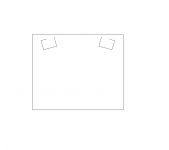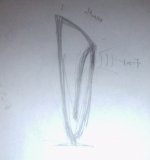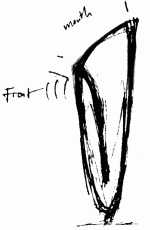I'm sure to open a can of worms with this.😱
I'm guessing that rear exits are generally in compact designs to help boost the lower frequencies- there is one horn builder in america who states that back horns should never exit at the front, I think it was something to do with the mid frequencies.
Any for and against arguments wd be interesting to read.
I'm guessing that rear exits are generally in compact designs to help boost the lower frequencies- there is one horn builder in america who states that back horns should never exit at the front, I think it was something to do with the mid frequencies.
Any for and against arguments wd be interesting to read.
No can of worms to open. You seem to be implying in your question that the same horn would be employed irrespective of terminus location; this would seldom be the case in a competent design since the location of the terminus should be integral from the inception, not considered at some later stage as an independent factor. All design types have their own compromises so there is no universal 'best' type -you pick what will best suit your design objectives.
Last edited:
What I've noticed is a recent shift from front to rear exit, even with fairly large commercial designs; so I'm curious as to if there is a growing consensus that rear exit is best, for whatever reason.
Not AFAIK. To an extent, this depends on who is out there at any given moment. There are actually quite a few small companies producing back-horn speakers, but many are only around for brief periods, usually due to a lack of exposure, high overheads and limited sales. What goes around comes around though -give it a few months and you'll probably find a bunch of new start-ups selling designs with forward firing termini.
As I say, it's all about picking the compromises that best meet your design goals. A back-horn with a rear terminus for example is usually designed for boundary loading, i.e. its expansion is set up for use in 1/4 or 1/8 radiation space. The room boundaries are part of the horn's expansion, effectively resulting in a larger horn which is impedance matched to a lower frequency than is likely in, say, a similar sized cabinet with a forward-firing termini (under most conditions). This is all very well & good, but it has its drawbacks too, notably greater reliance on the room acoustics. The in-room power-responses are thus generally very different, underlining the fact that there are no panaceas in audio. What works well in one situation may not in others. Personal taste, both acoustic and aesthetic also come into this.
As I say, it's all about picking the compromises that best meet your design goals. A back-horn with a rear terminus for example is usually designed for boundary loading, i.e. its expansion is set up for use in 1/4 or 1/8 radiation space. The room boundaries are part of the horn's expansion, effectively resulting in a larger horn which is impedance matched to a lower frequency than is likely in, say, a similar sized cabinet with a forward-firing termini (under most conditions). This is all very well & good, but it has its drawbacks too, notably greater reliance on the room acoustics. The in-room power-responses are thus generally very different, underlining the fact that there are no panaceas in audio. What works well in one situation may not in others. Personal taste, both acoustic and aesthetic also come into this.
Last edited:
I agree that room boundaries and speaker possible location in the room has to do with designing a front or back loaded horn. In my case, because of land being a premium, my listening rooms are usually smaller than most of the homes you find in larger countries (ie. Canada, USA, UK countryside, etc.). So, I tend to go with front ported, sealed, and front loaded horn speakers. But, I have found out that some rear ported/horn speakers give a great sound when close to a wall. Though not a horn, an example is the original PSB Alpha SE, though rear ported it was designed by Paul Barton to be placed close to a wall. So, there is no rule of thumb, maybe except for large ports/horns, a matter of trial and error to see what works and what doesn't.
The room boundaries are part of the horn's expansion.........
different corner loading.....I had completely forgot about it
maybe not very effective, but probably have some effect
Attachments
I personally think a rear horn has less impact from time delay compared to a front firing horn. Perhaps due to spewing less rubbish out into the mid ranges? They certainly sound different to my ears, with the exact same horn paths, and not just in depth or sound volume.
Perhaps due to spewing less rubbish out into the mid ranges?
Is it just an accepted, or down to bad design or maybe the length of line being too short? The Voxativ Ampeggios garner good reviews and no mention of this. Wd some kind of internal lining or stuffing help (obviously not so much as to defeat the purpose of a horn).
Last edited:
No it's not accepted as inevitable, yes it's mostly down to poor design, and yes, damping materials can be and regularly are used to attenuate unwanted higher frequencies.
Ok, the first sketch I did had a top exit, single fold. The line length looks ok but how about the limit in size of the mouth?
sorry, I can't unreverse it (mac photo booth😡)
Just take it into iPhoto for simple manipulation.
(photoshop)
Topologically the same as a BIB. It is a pretty shape. The sketch reminds me of the Cat in the Hat.
dave
Attachments
View attachment 332582
sorry, I can't unreverse it (mac photo booth😡)
Godzilla, this is the rough shape i had in mind a couple of days ago
An externally hosted image should be here but it was not working when we last tested it.
I did something similar (lost the real photos with camera and PC).
I'm either very sensitive to time smear or the single fold (rounded) with a slanted vent spews out a lot of rubbish. Was pretty heavily stuffed at one point which helped but murdered the output. Hitching the whole thing up on legs so the vent was closer the ceiling did help but still had quite a few substantial dips that would have needed more eq tweaks then I'd be willing to use.
Last edited:
If you feel you're especially sensitive to group delay, why are you playing with back-horns? Of all the vented enclosure types, they are the hardest to minimise the effects of GD in.
If you feel you're especially sensitive to group delay, why are you playing with back-horns? Of all the vented enclosure types, they are the hardest to minimise the effects of GD in.
Just ruling out feckless design. I don't particularly want to use woofers to get the driver low so trying one more with a double mouthed rear firing horn, then I will have to use an mltl crossed to subs around 80hz.
I thought it may have just been the driver but I borrowed some fe166's and made an MDF haruna and still had the same problem.
Ghastly combination. I can feel the panel resonance smearing from here.
I still maintain if you think you are especially sensitive to GD, just build a simpler box and have done with it.
I still maintain if you think you are especially sensitive to GD, just build a simpler box and have done with it.
- Status
- Not open for further replies.
- Home
- Loudspeakers
- Full Range
- back loaded horns, which is best, front or rear exit?


